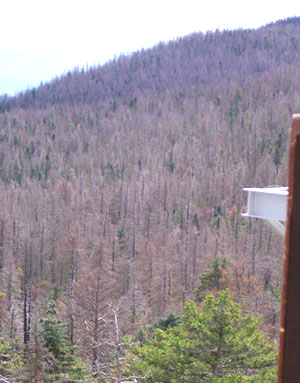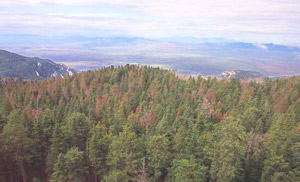Insect Outbreaks
Freezing and drought conditions in the southwest in recent years have set the
stage for a series of forest insect outbreaks in the upper elevations of the Pinaleño
Mountains on Mount Graham Red Squirrel Monitoring Program (RSMP) study areas. Since 1992, a cascade of disturbances has taken
place leading to the current conditions in the spruce-fir habitat (SF), most noticeably large areas of
standing dead/dying Engelmann spruce trees. In 1992, blowdown resulting from an ice
storm provided dead timber habitat for increasing bark beetle populations. In 1996-1998,
an obscure geometrid moth (Nepytia janetae) defoliated spruce and corkbark fir trees in
the areas surrounding Hawk and High Peaks, and Emerald Cienega. By 1998, several
highly destructive species of bark beetles had increased in spruce and fir trees likely weakened
by the moth. Engelmann spruce trees on
High, Hawk and Emerald Peaks have been affected by an introduced spruce aphid
(Elatobium abietinum), which was detected for the first time in the Pinaleños late in 1999.
In March 2000 trees as low as 2900 m elev. in transitional mixed conifer forest on RSMP
study areas were seen covered with aphids.
These outbreaks are of concern to the red squirrel because habitat is directly
affected by reduced cone production in physiologically stressed trees, and by
increased tree mortality (see photos below). Engelmann spruce has been particularly hard-hit. At this time,
Douglas-fir and white pine seem to be relatively unaffected. Occupancy of red
squirrel middens in these areas has decreased since the outbreaks began. The total
number of squirrels in the SF habitat has decreased from 72 in December 1997 to 8 in
December of 2001. The north slope of high elevation SF habitat, where the insect
activity has been the greatest, has shown the largest decrease. In December 1997,
there were 23 middens occupied in this area, and by December 2001, only 1 midden
remained occupied. Similar decreases in occupancy are happening at lower
elevations of the SF habitat where insect activity has occurred in areas around
Highwater cienega and the ridge running west from Emerald Peak.
For more information regarding insect outbreaks in the southwestern United States please visit the US Forest Service, Forest Health website.
(photos by Jim Slagle - taken from the Large Binocular Telescope during August 2001)
1. Looking north.

2. Looking south.

|
3. Looking east.

4. Looking west.

|
Back to top
 This largely unknown moth was first described in 1966 and is endemic to the White and Pinaleño Mountain ranges of AZ, and the Capitan and Sacramento Mountains of NM. The moth outbreak was checked by natural disease and parasites. Some larvae turned red and died as a result of an unknown pathogen. Many larvae were killed by parasitoids including a
tachinid fly, Madremyia saundersii (identification by Jim O'Hara, Agriculture and Agri-Food Canada), and two unidentified ichneumonid wasps.
This largely unknown moth was first described in 1966 and is endemic to the White and Pinaleño Mountain ranges of AZ, and the Capitan and Sacramento Mountains of NM. The moth outbreak was checked by natural disease and parasites. Some larvae turned red and died as a result of an unknown pathogen. Many larvae were killed by parasitoids including a
tachinid fly, Madremyia saundersii (identification by Jim O'Hara, Agriculture and Agri-Food Canada), and two unidentified ichneumonid wasps.
Photo by: Bruce Walsh
Back to top
 The spruce aphid attacks Picea spp. in the Pacific Northwest, Canada, Europe and other parts of the world. It is highly destructive to Engelmann spruce in the southwestern United States.
This species was first reported in Arizona in 1988 in the White Mountains, and in the Pinaleño Mountains in 1999 by Ann Lynch of the USFS Rocky Mt. Research Station. Populations may be limited by freezing weather, and it is unknown whether there are naturally occurring disease or predator checks. In the fall of 1999, RSMP personnel observed Mt. Graham red squirrels feeding on spruce aphids by gleaning them from branch tips. During the March 2000 census, many Engelmann spruce trees at lower elevations were also seen with heavy infestations of aphids.
The spruce aphid attacks Picea spp. in the Pacific Northwest, Canada, Europe and other parts of the world. It is highly destructive to Engelmann spruce in the southwestern United States.
This species was first reported in Arizona in 1988 in the White Mountains, and in the Pinaleño Mountains in 1999 by Ann Lynch of the USFS Rocky Mt. Research Station. Populations may be limited by freezing weather, and it is unknown whether there are naturally occurring disease or predator checks. In the fall of 1999, RSMP personnel observed Mt. Graham red squirrels feeding on spruce aphids by gleaning them from branch tips. During the March 2000 census, many Engelmann spruce trees at lower elevations were also seen with heavy infestations of aphids.
Photo by: U.S. Forest Service
Back to top
 The spruce beetle is the most significant natural mortality agent of mature spruce. It infests all Picea spp. within its geographic range. Outbreaks usually last 2-5 years and result in a depletion of large diameter spruce trees within the forest. Natural controls include cold winter temperatures as well as cold, wet weather during flight periods. The primary host of the western balsam bark beetle is subalpine fir (Abies lasiocarpa). Its range generally overlaps that of the alpine fir.
These species were first recorded in the Pinaleño Mountains in 1998 in areas of N. janetae defoliation. An approximate total of 730 acres of mature spruce and fir trees in the upper elevations has already been killed and an estimated additional 700 acres, in several lower elevation mixed conifer stands, have been affected. Bark beetle infested trees generally tend to die and fall within three years.
The spruce beetle is the most significant natural mortality agent of mature spruce. It infests all Picea spp. within its geographic range. Outbreaks usually last 2-5 years and result in a depletion of large diameter spruce trees within the forest. Natural controls include cold winter temperatures as well as cold, wet weather during flight periods. The primary host of the western balsam bark beetle is subalpine fir (Abies lasiocarpa). Its range generally overlaps that of the alpine fir.
These species were first recorded in the Pinaleño Mountains in 1998 in areas of N. janetae defoliation. An approximate total of 730 acres of mature spruce and fir trees in the upper elevations has already been killed and an estimated additional 700 acres, in several lower elevation mixed conifer stands, have been affected. Bark beetle infested trees generally tend to die and fall within three years.
Photo by: U.S. Forest Service
Back to top
[Home] [Monitoring Project]
This site maintained by the Mt. Graham Biology Program - The University of Arizona
If you have any questions or comments
please email us at:RSMP@ag.arizona.edu




 This largely unknown moth was first described in 1966 and is endemic to the White and Pinaleño Mountain ranges of AZ, and the Capitan and Sacramento Mountains of NM. The moth outbreak was checked by natural disease and parasites. Some larvae turned red and died as a result of an unknown pathogen. Many larvae were killed by parasitoids including a
tachinid fly, Madremyia saundersii (identification by Jim O'Hara, Agriculture and Agri-Food Canada), and two unidentified ichneumonid wasps.
This largely unknown moth was first described in 1966 and is endemic to the White and Pinaleño Mountain ranges of AZ, and the Capitan and Sacramento Mountains of NM. The moth outbreak was checked by natural disease and parasites. Some larvae turned red and died as a result of an unknown pathogen. Many larvae were killed by parasitoids including a
tachinid fly, Madremyia saundersii (identification by Jim O'Hara, Agriculture and Agri-Food Canada), and two unidentified ichneumonid wasps.
 The spruce aphid attacks Picea spp. in the Pacific Northwest, Canada, Europe and other parts of the world. It is highly destructive to Engelmann spruce in the southwestern United States.
This species was first reported in Arizona in 1988 in the White Mountains, and in the Pinaleño Mountains in 1999 by Ann Lynch of the USFS Rocky Mt. Research Station. Populations may be limited by freezing weather, and it is unknown whether there are naturally occurring disease or predator checks. In the fall of 1999, RSMP personnel observed Mt. Graham red squirrels feeding on spruce aphids by gleaning them from branch tips. During the March 2000 census, many Engelmann spruce trees at lower elevations were also seen with heavy infestations of aphids.
The spruce aphid attacks Picea spp. in the Pacific Northwest, Canada, Europe and other parts of the world. It is highly destructive to Engelmann spruce in the southwestern United States.
This species was first reported in Arizona in 1988 in the White Mountains, and in the Pinaleño Mountains in 1999 by Ann Lynch of the USFS Rocky Mt. Research Station. Populations may be limited by freezing weather, and it is unknown whether there are naturally occurring disease or predator checks. In the fall of 1999, RSMP personnel observed Mt. Graham red squirrels feeding on spruce aphids by gleaning them from branch tips. During the March 2000 census, many Engelmann spruce trees at lower elevations were also seen with heavy infestations of aphids. The spruce beetle is the most significant natural mortality agent of mature spruce. It infests all Picea spp. within its geographic range. Outbreaks usually last 2-5 years and result in a depletion of large diameter spruce trees within the forest. Natural controls include cold winter temperatures as well as cold, wet weather during flight periods. The primary host of the western balsam bark beetle is subalpine fir (Abies lasiocarpa). Its range generally overlaps that of the alpine fir.
These species were first recorded in the Pinaleño Mountains in 1998 in areas of N. janetae defoliation. An approximate total of 730 acres of mature spruce and fir trees in the upper elevations has already been killed and an estimated additional 700 acres, in several lower elevation mixed conifer stands, have been affected. Bark beetle infested trees generally tend to die and fall within three years.
The spruce beetle is the most significant natural mortality agent of mature spruce. It infests all Picea spp. within its geographic range. Outbreaks usually last 2-5 years and result in a depletion of large diameter spruce trees within the forest. Natural controls include cold winter temperatures as well as cold, wet weather during flight periods. The primary host of the western balsam bark beetle is subalpine fir (Abies lasiocarpa). Its range generally overlaps that of the alpine fir.
These species were first recorded in the Pinaleño Mountains in 1998 in areas of N. janetae defoliation. An approximate total of 730 acres of mature spruce and fir trees in the upper elevations has already been killed and an estimated additional 700 acres, in several lower elevation mixed conifer stands, have been affected. Bark beetle infested trees generally tend to die and fall within three years.